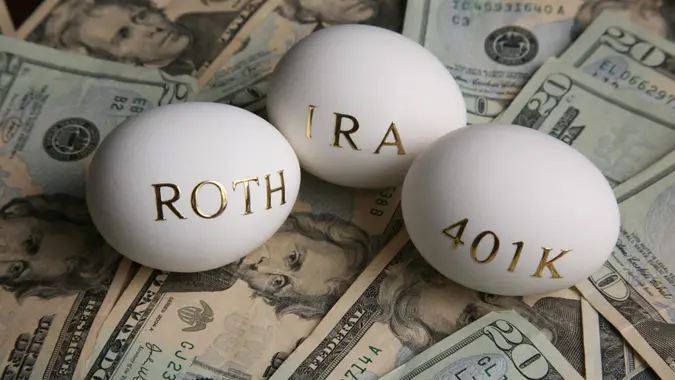4 Ways To Build Your Retirement Fund Even If You Work Hourly

Commitment to Our Readers
GOBankingRates' editorial team is committed to bringing you unbiased reviews and information. We use data-driven methodologies to evaluate financial products and services - our reviews and ratings are not influenced by advertisers. You can read more about our editorial guidelines and our products and services review methodology.

20 Years
Helping You Live Richer

Reviewed
by Experts

Trusted by
Millions of Readers
Just because you’re paid hourly doesn’t mean you can’t save for retirement. Part-time and hourly employees can also receive workplace benefits, like access to a 401(k) plan.
But what if your income is relatively low? According to the U.S. Bureau of Labor Statistics, the median weekly earnings of full-time employees (those who work at least 35 hours a week) is $1,196. Assuming a 35-hour workweek, that’s around $34 an hour.
As for how you can use that hard-earned cash — and potential benefits — to build your retirement fund, here are some options.
Contribute to a 401(k) Plan
You don’t need to be a full-time employee to qualify for a 401(k) plan. However, you might need to meet other requirements, like:
- Work at least 1,000 hours in a 365-day period
- Be 21 or older
- Have one or two years’ of service at the company
Different plans have their own requirements, but the point is you could still be eligible as an hourly employee.
“If your employer offers a 401(k) with a match, try to contribute at least enough to get the full match. Even a small 2% contribution from your paycheck can double with a match and help you build savings without feeling the hit too much,” said Andrew Latham, certified financial planner (CFP) at SuperMoney.
Contribute to a Roth IRA
A Roth IRA is a separate retirement arrangement you can open even if your workplace doesn’t offer a 401(k). You can also open one if you’re self-employed.
You can contribute up to $7,000 in a Roth IRA each year. To qualify, you must earn no more than $150,000 to $165,000 (if your filing status is single or head of household).
It’s okay if you can’t max out your Roth IRA. Even small, but regular contributions can help get you on track for retirement.
Say you’re 25 years old, get paid once a month and can put $100 per paycheck into your Roth IRA. Assuming a 7% annual return and consistent contributions, you’ll have around $239,562 when you reach 65. Your money would grow tax-free. Your distributions would also be tax-exempt.
Set Aside a Percentage of Your Income
Fidelity suggests saving 15% of your income every year for retirement. Following this rule, someone who earns $80,000 annually would set aside $12,000 for retirement.
But this isn’t feasible for everyone, and that’s okay. The main goal is to start saving and to do it consistently. You can always increase your numbers as you go.
“Gradually raising your savings rate and consistently investing in the markets allows you to harness the power of time and compounding,” said Robert Rickey, CFP, certified pension consultant (CPC) and chief growth officer at StraightLine. “This is especially powerful for younger workers who may have 40 or more years until retirement, but no matter your age, the most important step is to get started today.”
Invest Extra Money When You Can
Whether you’re hourly or not, it’s smart to save — and invest — extra cash when you’ve got it. For example, you could put your tax refund into your Roth IRA. The average tax refund in 2025 is a little over $3,000, according to the IRS. That’s nearly half of your annual contribution limit.
If you earn money from a side gig, save as much as possible. Of course, if you have high-interest debts, you might want to prioritize paying those off first. And if you don’t have an emergency fund, start saving up for those unexpected expenses. Doing so can protect your retirement funds.
More From GOBankingRates
 Written by
Written by  Edited by
Edited by 

























